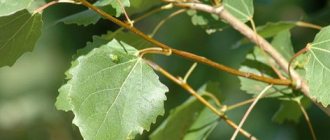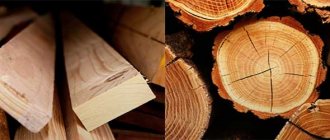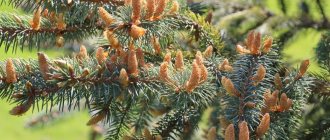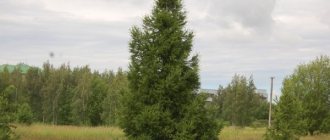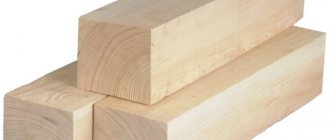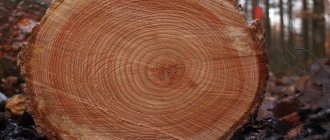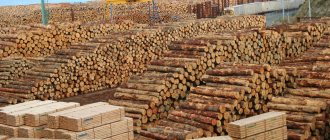Description of the genus
The term "conifer" describes most of the evergreen plants that exist on Earth. All of them belong to the group of gymnosperms that appeared on the planet a very long time ago. The group consists of several divisions and conifers are one of them. It includes: cypress, larch, spruce, pine, fir, cedar, as well as a number of shrubs.
Spruce belongs to the Pine family. These are vigorous, conical trees that reach a height of 20–60 m at maturity. Representatives of the family are identified by their “leaves,” that is, needles.
On pine trees they are attached to a branch:
- 2 pcs. - in red pines;
- 3 pcs. - yellow ones;
- 5 pcs. - from the whites.
Translated from Latin, the genus name “Picea” means “resinous”, which fully reflects the properties of needles. In total, there are more than 35 species of spruce in the world. They grow in open areas. They are found everywhere in the Far East, China, Canada, and North America. On average, they live up to 300 years, but there are also centenarians who are more than 600 years old.
Did you know? In Swedish forests, Norway spruce fossils date back to the early Holocene
-
about 9,500 years ago.
There is evidence that young fir trees grew from the old root system of a dead tree. Spruce trees have shorter needles, and they are located on the branch, like on a brush. In texture and shape, these needles are faceted and hard. Fir has similar needles, but softer. The color and length of the needles are not considered reliable means of identification, since these parameters may vary depending on the conditions and location of growth.
Description:
- The height depends on the type of spruce. Among them there are both vigorous-growing ones, with a maximum height of up to 90 m, and dwarf specimens - no higher than 1.5 m.
- There is only one trunk, like most trees. The bark can serve as an age identifier. On young spruce trees it is smooth and gray. As it grows it becomes furrowed.
- The branches grow at an angle of 45 degrees upward. Scientifically, this is called “in an inverted position.” The lower branches are wider and longer than the upper ones.
- The needles are short and rigid. Each grows from its own growing point and is attached to the branch by a small stem-like woody protrusion. The needles are not round, but square in cross-section, which is always noted as one of the main distinguishing features of the tree. If you remove the needle, the protrusion is removed along with it.
- Buds are red-brown. Before opening, they are 5 mm long, including the sharp apex.
- The cones of spruce trees at the beginning of development are green or purple. As they grow, they become reddish or golden brown in color. The shape is smooth. The cones grow upward like candles. And this is the second distinctive feature of this tree.
- Ovoid-oval seeds ripen in the cones. Their scales are thin, wavy and irregularly jagged. The tree produces a seed between 20 and 60 years of age. Therefore, if you are planting it for seeds, do not expect harvest too early.
In autumn, spruce, like other conifers, sheds its old needles. Therefore, the internal areas of the tree may become exposed. Each needle grows from its appearance to its fall for 3 years, reaching a length of 2 cm.
Reproduction of spruce
New trees can be obtained using seeds and cuttings. The latter are popular among amateurs. For the rootstock, you can use another coniferous tree. The main condition is its high frost resistance.
Rooting should be done in early spring. The gardener must be in time before the buds swell. Stems with smaller branches are used as cuttings. The shoot should have a length of 6-10 cm. After it is cut, it must be treated with a growth stimulator. The optimal landing angle is 30 degrees. The soil mixture is prepared from sand and peat. Instead of the last ingredient, you can use fine perlite. The soil is covered with drainage and turf soil. The thickness of the first layer should be at least 5 cm, the second - about 10 cm.
To grow a spruce using the generative (seed) method, it will require a lot of expense and time. In this case, seed material that has retained germination is used. The seeds are extracted from ripe cones. They are pre-dried. To carry out stratification, peat or dry sand is used. The next step is freezing. The seeds are kept in the refrigerator for 1-1.5 months. Sowing is carried out in late February-early March. Using this method, the gardener will receive plants that will be characterized by slow growth, low resistance to strong gusts of wind, scorching sun and excessive humidity.
Distribution in nature
Norway spruce is a major conifer species, dominant in boreal and subalpine coniferous forests. Distributed in the mountains of Central, Northern and Eastern Europe, the Ural Mountains. Then it is replaced by forests of Siberian spruce. Outside Europe, it is common in the USA and Japan. Some species are even native to South Africa, Tasmania and New Zealand.
Important! Spruce has a superficial root system. Therefore, a strong storm wind can easily knock down a tree if it is not strengthened.
Distribution area of individual spruce species:
- Brewera (Picea breweriana) - North America;
- Sitka (Picea sitchensis) - Pacific Coast, North America;
- Chinese (Picea brachytyla) - China;
- Chihuahuan (Picea chihuahuana) - Mexico;
- Maksimovich (Picea maximowiczii) - Japan;
- Morrison (Picea morrisonicola) - Taiwan;
- Eastern (Picea orientalis) - Caucasus, Turkey;
- Shrenka (Picea schrenkiana) - Central Asia, Tien Shan mountains;
- Himalayan or Smitta (Picea smithiana) - Himalayas;
- Ayan or Hokkaido (Picea jezoensis) - Kamchatka, northern Asia;
- Siberian blue (Picea obovata) - Siberia.
Although spruce grows well on most types of substrates, it is most often found on acidic soils with fairly low humidity. As the tree grows, it tends to oxidize the soil. In boreal forests it grows next to birch, European aspen, and willow. Commonly found along streams and lakes. In the Alps it forms pure spruce forests or in combination with European larch and Swiss cedar. At higher elevations it grows with Scots fir. At medium altitudes, up to 1800 m, it is found next to pine.
Popular types of fir trees
Main types of spruce:
1. Black (Picea mariana) and white (P. glauca) are found throughout much of northern North America. Both trees produce excellent timber. And black is also a source of spruce gum. White spruce trees grow up to 21 m. Both varieties are drought-resistant and useful in landscape design. Black spruces differ from white spruce trees by having a denser coniferous cover of small needles and rounded cones. There are also many morphological differences at the needle and pollen level, but these can only be detected under a microscope.
Did you know? The outer fragments of the bark were used as tiles to cover the roofs of houses or as siding in smokehouses.
Softwood bark panels are said to be good at maintaining internal temperature during smoking. Black spruce (P. mariana) is widespread in Canada and the United States. This is a cone-shaped tree about 15 m high. Under favorable conditions, it grows up to 30 m. Black spruces differ from ordinary spruce trees in that they have cones that hang down. Tree landscaping can be asymmetrical. There is much less of it on the windy side. Black spruces are the first to “develop” peat bogs, so they are well suited for growing on any other soil. Their wood is not of great value due to their relatively small size, but is highly durable.
White spruce grows in temperate and boreal forests of North America . This is the northernmost species of spruce, with stands extending north to 69° north latitude. It is also considered the hardiest species, withstanding winter temperatures down to -50°C. Grows up to 40 m in height. It has a narrow conical crown, which becomes cylindrical in old trees.
Thanks to the efforts of breeders, this tree is represented by many varieties:
Rainbow's End dwarf Canada spruce (Picea glauca Rainbow's End) has distinctive bright creamy yellow new growth. And the variety got its name “rainbow” because it produces 2 growths per year: in the spring - light green, and in the summer - yellow. It looks very impressive against the background of dark green, older needles. By the age of ten, the variety reaches a height of 1 m.
Daisy's White (Picea glauca Daisy's White) is also a compact variety. In 10 years it grows slightly higher than 60 cm. The variety is characterized by shoots of a light cream color. Suitable for both open ground and container growing.
Canadian blue spruce (Picea glauca Blue Wonder) has needles of a steel-blue hue. And this makes her extremely attractive. The needles are located very densely, so the tree looks like a solid bluish cone. A mature tree reaches a height of 1.5 m.
Canadian Sanders Blue (Picea glauca Sanders Blue) is a very decorative variety with bright blue needles. Young growth of a lighter shade looks good against the background of last year's darker needles. The tree is compact. The shape is regular conical. It grows very slowly - no more than 4 cm per year. By the age of ten it does not exceed 0.7 m.
2. Engelmann spruce (P. engelmannii) is native to North America and is also an important source of timber. Due to its bluish needles and symmetrical cone-shaped shape, it is often used as an ornamental plant. Forms forests together with fir and larches. The tree's shape is a long column with a pointed crown and sometimes drooping lower branches. Grows up to 25 m. Branches tend to grow symmetrically. If you break a branch, a characteristic pine aroma spreads around. Used as an ornamental tree throughout Europe. It is well known to many as a New Year tree. It is also valued for its wood, which is used in the manufacture of acoustic guitars, harps, violins and pianos.
3. Sitka (Picea sitchensis) is valued for its timber. Today it is the largest species of spruce in the world. Its height reaches 91 m. It lives for more than 700 years. This is the only variety with flattened needles, with a small “keel” at the bottom. The shape of the tree is columnar with a pointed crown. The branches are of different lengths, giving it a more open appearance. The wood is considered light, strong and flexible. It is used in shipbuilding, has excellent acoustic properties and is used to make pianos and other musical instruments.
4. Brewera is one of the rarest species in North America. Listed in the International Red Book. Also called weeping because the main skeletal branches contain secondary branches that hang vertically down. They can reach a length of 2 meters, making the spruce look like a weeping willow. The height of the tree reaches 54 m, and the width of the trunk is up to 1.5 m. It grows very slowly, usually less than 20 cm per year. Tolerates harsh conditions well. The branches are adapted to withstand sharp gusts of wind and icy masses of snow.
5. Chinese or Sargenta - grows everywhere in China in mountainous areas. Its differences: rough gray bark, purple-brown young cones, thin sparse needles. It reaches a height of 50 m. Its wood is used to make furniture, flooring, and wood shavings are used to make paper. It is rarely planted in garden design due to its high altitude.
6. Martinez got its name in honor of the botanist who discovered it in 1981. It grows in only two places in Mexico: Sierra Madre and Nuevo Leon. Grows up to 35 m. The shape of the tree is conical. The needles are bright green. The cones are conical, green when they appear, and after ripening they become orange-brown. They are pendular in shape, wide-cylindrical, 8–16 cm long and 3 cm wide when closed. Martinez spruce has some of the largest nuts in the world. But at present they are used not for food, but to renew the plant population. The tree is one of the most heat-loving species. Its USDA hardiness zone is 9-10, with winter temperatures ranging from -7°C to -1°C.
Features of planting a coniferous tree
To ensure that your efforts to plant spruce are not in vain, you must follow some rules.
At the initial stage, you need to choose a place suitable for planting a tree. It must meet the following requirements:
- The area should be well lit.
- The soil should not have groundwater at shallow depths.
- The ideal place to grow a healthy tree is loose or sandy soil.
Immediately before you start planting a spruce tree, you must prepare in advance a special earthen mixture that will contain all the necessary substances for the successful survival of the young seedling. This composition includes:
- Two parts of sand.
- Three parts peat.
- Nitroammophosphate is added at the rate of 15 grams per square meter.
If there are concerns that the soil has excessive moisture, then it is worth making drainage in advance. It is created in the following way. Expanded clay or fragments of broken brick are poured into the bottom of a pre-dug hole. The thickness of the drainage layer is on average up to 30 cm.
A seedling with the most developed root system and healthy appearance is selected for planting. Its height should not exceed two meters. The tree is carefully placed in the hole and after digging in, watered generously with water.
When planting, you need to pay attention to the root collar; it should be slightly above ground level. Watering a young seedling during the growing season is carried out regularly, once a week.
Application
Spruce is one of the most important conifers in Europe, both economically and environmentally. It is grown to produce solid wood for wooden structures and pulp for paper production.
Also planted to combat soil erosion. Wood is considered one of the best for soil health. In addition, they are a popular New Year's symbol that we are used to seeing everywhere. Wood materials are used to make carpentry, furniture, veneer, piano boards, and guitars.
Stradivarius and other prominent Italian violin makers used wood from the forests of Norway to make violin bodies. However, the material itself is short-lived and requires increased rot resistance thanks to sealing substances, for example, varnishes.
In folk medicine
Raw materials obtained from spruce plants have long been used as a basis for medicines, based on:
- oils obtained from pine needles;
- pollen;
- resin;
- needles;
- buds and young shoots.
For medicinal purposes it is used for:
- cough;
- cold;
- bronchitis;
- tuberculosis;
- fever;
- pain and swelling (inflammation) of the mouth and throat;
- muscle pain;
- arthritis.
Coniferous components are effective in the fight against bacterial infections. Fir cones were used to make tea for colds.
To prepare tea you need:
- Collect 5-15 cones and boil them for 10-15 minutes in a pan of water. The longer the boiling time, the richer the resulting broth will be.
- Then the drink must be infused and strained for an hour.
- Use to relieve cough, sore throat and chest pain 3 times a day, a quarter cup (50 g).
- The course lasts 3–5 days. The decoction can be stored in the refrigerator.
Baths from a decoction of pine needles will be appropriate for rheumatism. They restore blood circulation, normalize blood vessels and reduce pain. The sticky resin secreted by the tree is used to relieve inflammation and irritation of the skin. To do this, it is applied to a warm cloth and applied to the sore area. Apply a bandage and keep it in this form until the liquid component is completely absorbed into the skin.
Important! The correct dose of spruce medicine used depends on several factors, including the age of the patient, the presence of chronic diseases, and general health. Therefore, when using this remedy, adjust the dosage according to how you feel.
The inner bark has always been used as a wound healing agent. To do this, the bark was removed from the cut tree, and its inner white layer was scraped off with a knife. It was chewed to relieve cold symptoms or applied to wounds.
Spruces are planted in medical institutions. Their phytoncides heal and purify the air. Fresh shoots contain essential oils rich in terpenes, which provide the antiseptic, antibacterial and mucolytic properties of spruce. Inhaling air filled with ethers helps patients recover faster and acts as a general tonic.
In industry
The industrial use of spruce began a very long time ago. In Scandinavian countries, ropes, boats, and fishing nets were made from its roots. In the spring, after floods, dead trees remained on the banks of reservoirs. Their roots were divided into parts and weaved into nets. When not in use, they were stored in water to prevent the fibers from drying out. Snowshoes, stretchers, shafts for shovels and other agricultural implements were made from young trunks.
The texture of spruce wood is smooth. And this makes it very good as a building material. Spruce is a light wood species that is convenient to use for low loads.
Used to make:
- decorative plywood;
- veneer;
- internal floors;
- factory flooring;
- general carpentry;
- manufacturing of joinery products.
Spruce also exhibits good resonant qualities, which is why it is used in the manufacture of musical instruments.
In landscape design
Spruce trees, especially dwarf varieties (up to 1 m in height), find their use in landscape design.
Check out the best varieties of spruce trees for landscape design.
They can be used in the following capacities:
- for decorating garden paths, if the planting is formed “in a row”;
- for visual marking of different park areas;
- for landscaping the territory of a medical institution and improving air quality.
Larger varieties are planted as a protective cordon to protect more delicate plants - roses, peaches - from the winds. If the site is located on a slope, the roots can strengthen the soil and prevent the soil from moving from the beds. Large trees are planted in front of buildings in order to be able to decorate them during the Christmas and New Year holidays, thereby creating a festive mood for themselves and passers-by.
for the new year
Norway spruce is a universally recognized favorite of the New Year holidays. Pagans used its branches to decorate their houses during the winter solstice. Spruces were probably first used as Christmas trees about 1,000 years ago.
Did you know? Bark beetle
is
the most dangerous pest of conifers, easily destroying entire forest areas in a short period of time.
Strong spruce branches can hold hundreds of garlands and decorations. The needles do not fall off, so the toys are held firmly on the branches. And the whole composition as a whole will decorate the territory for a very long time. After the New Year holidays, such a tree is cut into lumber and then used in construction.
Spruces can grow almost anywhere. If you choose the right varieties, you can decorate the area and at the same time obtain useful ingredients for medicinal purposes. Dwarf trees do not take up too much space. Therefore, you can easily plant a couple of beautiful spruce trees if you have free space.
Collection and preparation
Harvesting spruce needles is carried out twice a year - at the end of spring and at the beginning of winter, when the most valuable substances are present in the needles. The shoots are cut in March before the sap begins to flow in the tree, and the resin is collected in the summer.
Spruce needles and branches are dried in the open air under a canopy or in a warm, ventilated room. After the moisture has evaporated, the raw materials are poured into paper bags and stored in a dark closet. Fresh spruce resin also needs to be dried and stored in glass jars.
Spruce branches and needles can be used for medicinal purposes for up to a year, and resin - up to five years
